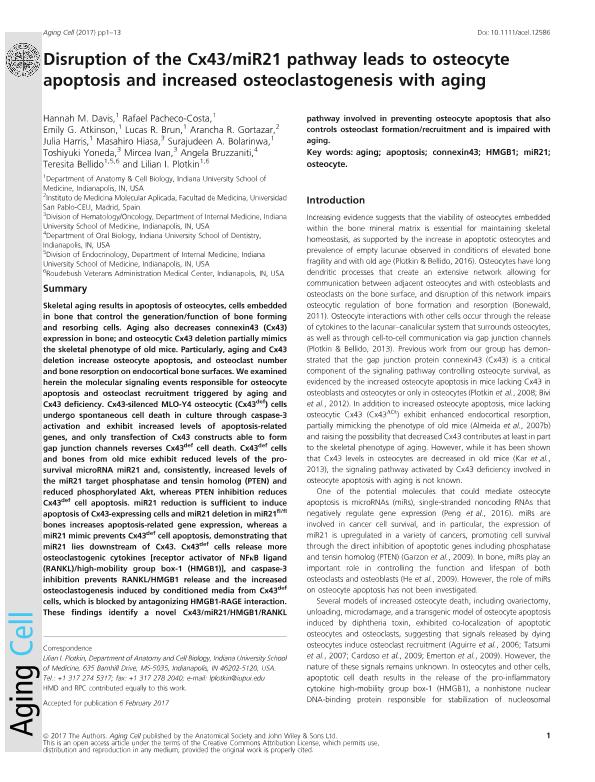Artículo
Disruption of the Cx43/miR21 pathway leads to osteocyte apoptosis and increased osteoclastogenesis with aging
Davis, Hannah M.; Pacheco Costa, Rafael; Atkinson, Emily G.; Brun, Lucas Ricardo Martín ; Gortazar, Arancha R.; Harris, Julia; Hiasa, Masahiro; Bolarinwa, Surajudeen A.; Yoneda, Toshiyuki; Ivan, Mircea; Bruzzaniti, Angela; Bellido, Teresita; Plotkin, Lilian I.
; Gortazar, Arancha R.; Harris, Julia; Hiasa, Masahiro; Bolarinwa, Surajudeen A.; Yoneda, Toshiyuki; Ivan, Mircea; Bruzzaniti, Angela; Bellido, Teresita; Plotkin, Lilian I.
 ; Gortazar, Arancha R.; Harris, Julia; Hiasa, Masahiro; Bolarinwa, Surajudeen A.; Yoneda, Toshiyuki; Ivan, Mircea; Bruzzaniti, Angela; Bellido, Teresita; Plotkin, Lilian I.
; Gortazar, Arancha R.; Harris, Julia; Hiasa, Masahiro; Bolarinwa, Surajudeen A.; Yoneda, Toshiyuki; Ivan, Mircea; Bruzzaniti, Angela; Bellido, Teresita; Plotkin, Lilian I.
Fecha de publicación:
06/2017
Editorial:
Wiley Blackwell Publishing, Inc
Revista:
Aging Cell
ISSN:
1474-9718
e-ISSN:
1474-9726
Idioma:
Inglés
Tipo de recurso:
Artículo publicado
Clasificación temática:
Resumen
Skeletal aging results in apoptosis of osteocytes, cells embedded in bone that control the generation/function of bone forming and resorbing cells. Aging also decreases connexin43 (Cx43) expression in bone; and osteocytic Cx43 deletion partially mimics the skeletal phenotype of old mice. Particularly, aging and Cx43 deletion increase osteocyte apoptosis, and osteoclast number and bone resorption on endocortical bone surfaces. We examined herein the molecular signaling events responsible for osteocyte apoptosis and osteoclast recruitment triggered by aging and Cx43 deficiency. Cx43-silenced MLO-Y4 osteocytic (Cx43def) cells undergo spontaneous cell death in culture through caspase-3 activation and exhibit increased levels of apoptosis-related genes, and only transfection of Cx43 constructs able to form gap junction channels reverses Cx43def cell death. Cx43def cells and bones from old mice exhibit reduced levels of the pro-survival microRNA miR21 and, consistently, increased levels of the miR21 target phosphatase and tensin homolog (PTEN) and reduced phosphorylated Akt, whereas PTEN inhibition reduces Cx43def cell apoptosis. miR21 reduction is sufficient to induce apoptosis of Cx43-expressing cells and miR21 deletion in miR21fl/fl bones increases apoptosis-related gene expression, whereas a miR21 mimic prevents Cx43def cell apoptosis, demonstrating that miR21 lies downstream of Cx43. Cx43def cells release more osteoclastogenic cytokines [receptor activator of NFκB ligand (RANKL)/high-mobility group box-1 (HMGB1)], and caspase-3 inhibition prevents RANKL/HMGB1 release and the increased osteoclastogenesis induced by conditioned media from Cx43def cells, which is blocked by antagonizing HMGB1-RAGE interaction. These findings identify a novel Cx43/miR21/HMGB1/RANKL pathway involved in preventing osteocyte apoptosis that also controls osteoclast formation/recruitment and is impaired with aging.
Palabras clave:
Aging
,
Apoptosis
,
Connexin43
,
Hmgb1
,
Mir21
,
Osteocyte
Archivos asociados
Licencia
Identificadores
Colecciones
Articulos(CCT - ROSARIO)
Articulos de CTRO.CIENTIFICO TECNOL.CONICET - ROSARIO
Articulos de CTRO.CIENTIFICO TECNOL.CONICET - ROSARIO
Citación
Davis, Hannah M.; Pacheco Costa, Rafael; Atkinson, Emily G.; Brun, Lucas Ricardo Martín; Gortazar, Arancha R.; et al.; Disruption of the Cx43/miR21 pathway leads to osteocyte apoptosis and increased osteoclastogenesis with aging; Wiley Blackwell Publishing, Inc; Aging Cell; 16; 3; 6-2017; 551-563
Compartir
Altmétricas



